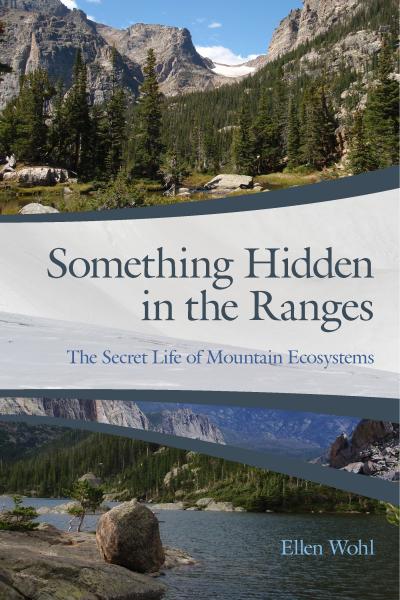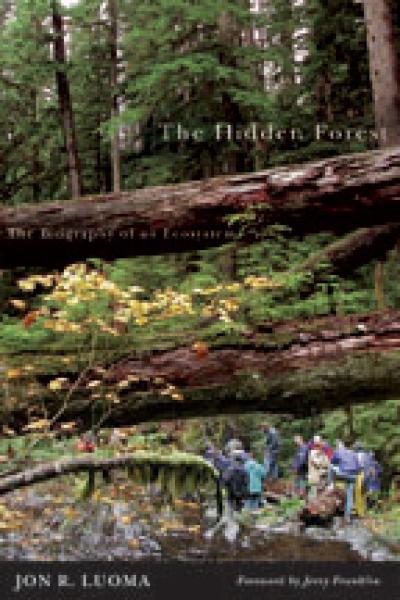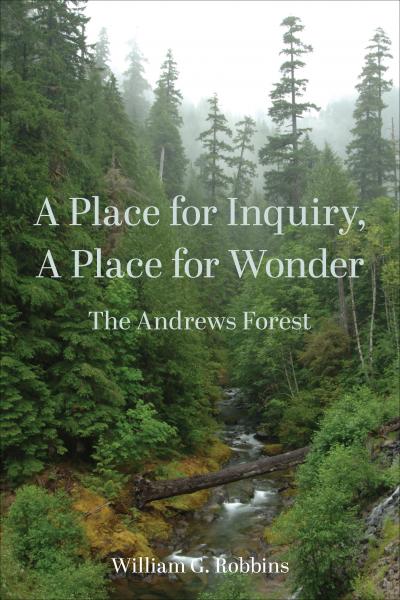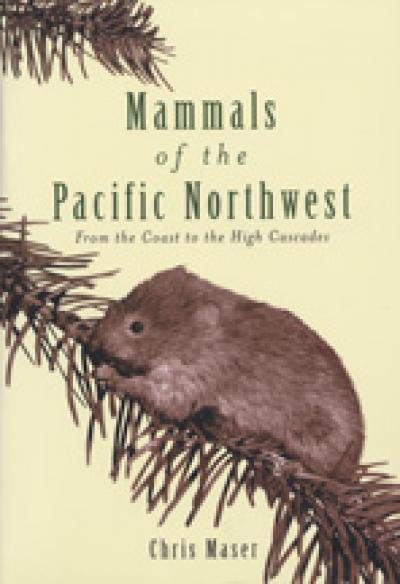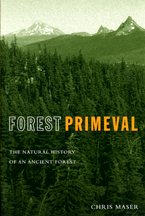
Forest Primeval
Chris Maser
With a new preface and epilogue by the author.
In this classic work of ecology, Chris Maser traces the growth of an ancient forest in Oregon's Cascade mountains from its fiery birth in the year 987 to present. A unique "biography" of an ecosystem, Forest Primeval portrays a diverse fabric of plants, animals, and microorganisms working in unison.
Maser offers precise yet evocative accounts of the lives and events within the burgeoning forest: the habits of deer mice who help reseed the burned earth, the seemingly accidental but vitally necessary symbiotic associations between fungus and tree root tips that stimulate growth, the constant predation among wildlife. He revels how over the course of a millennium, "microbes and fungi change a forest just as surely as a raging fire, only inconspicuously and more slowly."
As the life cycles of the forest progress, Maser's minute scientific observations unfold against the backdrop of history, a chronology of "humans struggle and suffering that is paralleled in the life of ..." a single 1000-year-old Douglas fir." In taking this millennial view, Maser shows how the forest represents our spiritual and historical roots as human beings. Arguing that our survival is as intertwined with the forests as are the myriad interlocking life cycles that created them, Maser makes a plea for the immediate global implementation of restoration forestry.
Selected by School Library Journal as one of the year's "Best Science and Technical Books."
About the author
Chris Maser spent over 20 years as a research scientist in natural history and ecology. He currently lives in Corvallis, Oregon, where he writes about and consults on sustainability issues. He is the author of numerous books, including Forest Primeval: The Natural History of an Ancient Forest (Oregon State University Press, 2001), and co-author of Fleas of the Pacific Northwest (Oregon State University Press, 1988).
Read more about this author
Preface
Acknowledgments
Introduction
In the Beginning
Birth of a Forest
987; 988; 993; 998; 1000; 1010
Young Forest
1020; 1037; 1042; 1075; 1080; 1099
Mature Forest
1112; 1137; 1187; 1210; 1215; 1223-1228
Ancient Forest
1237; 1247; 1252; 1274; 1287; 1337; 1412; 1429-1430; 1451; 1492; 1513; 1526; 1555; 1620; 1621; 1691; 1787; 1803-1806; 1812-1815; 1832-1834; 1840-1849; 1850-1869; 1870-1899; 1900-1929; 1930-1949; 1950-1957; 1958; 1960; 1963-1964; 1965; 1966-1967; 1969-1973; 1974-1987; 1988
Epilogue
Glossary
Scientific and Common Names of Plants and Animals Cited in Text
References
Index
I always write the introduction to a book at least three times: first, before I write the text so I know what it is that I think I'm going to write about; then again while I'm writing the text, so that the introduction more closely reflects what it is that I think I'm writing about; and finally, when I've finished the text, so that the introduction most closely reflects what it is that I think I wrote about. In this way, I watch not only a book evolve but also myself, and it occurs to me that each book is an autobiography of my own inner journey.
Forest Primeval is no different. Writing this book has forever changed my sense of the forest, my sense of humanity, amy sense of history, my sense of the humanity of history, and my sense of the history of humanity. We, the human species--whether we think so or not, whether we like it or not--are active participants in the creation of the world and the Universe. We are writer-actors on the stage of change; we are editing, writing, and rewriting the course of Nature's history, and we often become entrapped into acting out our short-sighted, poorly written, poorly constructed script.
I find this to be particularly true for those of us reared in the philosophical traditions of Western civilization. I, for example, was raised according to the biblical proclamation in Genesis that we human beings are the master of the Earth. This means, as Joseph Campbell points out, that the Judeo-Christian religion "God is separate from nature, and nature is condemned of God, "that we human beings can create a more perfect world than that of Nature. This notion carries over into the language of our European-American culture: take, for example, the words natural and history from the subtitle of this book.
The word natural in today's usage as an adjective connotes that which is inherently of pristine Creation. To many people this connotation means unspoiled by human hands, suggesting that somehow humanity is not a natural part of the Universe and therefore really does not belong here.
If, on the other hand, we could go back in time and forget our civilized selves long enough to join the primitive peoples of the earth, we would find them to have been the epitome of natural harmony with the environment in which they lived. True, primitive peoples survived largely by hunting and killing and lived in a world in which life was always balanced on an exceedingly fine line between earthly existence and non existence--the hunter and the hunted. To survive in such a violent world, primitive peoples reconciled themselves with Creation through their myths and rituals--their metaphors of -Creation and through their spiritual connection with the Creator, of which they were but a manifestation. Simply put, their lives were spiritual Creation because they lived their myths through enacted rituals that remained in harmony with their changing environment. They understood that their Universe was always in creation, always changing, and never created, never static or absolute; they accepted Creation as the constant in their lives and adapted themselves to it through the continuity of their myths. Primitive peoples knew who they were and where they belonged in and of Creation.
We, the "enlightened" peoples of Western civilization, on the other had, have forgotten our place in the Universe. This is not really surprising. Our ancestors came from afar, from the pastoral scenes of Europe, and they saw not a land to be understood and nurtured but a wild untamed continent to be conquered. Why? Because they came from civilized countries with civilized myths and rituals and felt that they were being rudely thrust into an uncivilized continent inhabited by savages and wild beasts, the conquest of which was their duty.
What our ancestors did not understand, however, was that their myths belonged to another place and another time in the evolution of humanity and were not comparable with those of the primitive peoples of the New World. The myths of the Native Americans belonged to the land they inhabited, whereas those of our ancestors belonged to a land halfway around the world. But in line with a perfectly human tendency, our ancestors' first inclination was to survive in the wild, unknown continent and then to seek that which was familiar and comfortable to trying to force their myths from an "old" known world onto a "new" unknown world.
At best, our European ancestral myths were inharmonious with the land and the native peoples; at worst they were in a collision course with human survival on Earth. And somewhere along the way, we have forgotten who we are. We have lost our identity and our sense of place in and of Creation.
Now let's consider the word history. History, by definition, is of the past, but it is also of the present and of the future; yet in reality, the present is all there is. Both past and future are but illusions of the present and therefore inescapable as continuing cycles in our ever-changing Universe. History, therefore, is but a glimpse into the eternal cycle of Creation, a perceived reflection of what is, a ghost of what might have been, a dream of what might yet be. Creation is that which has, is, and will inexorably draw humanity and the ancient forest into the crucible of cosmic interrelatedness where the forest will mirror for humanity the consciousness of its own evolving self.
The way we use words defines both our myth and our sense of history. Although the Native Americans and the european Americans alike depended on the health and richness of the earth for sustenance, the Native Americans worshiped the Earth as sacred, and the European Americans treated what they called soil as a commodity to be owned. Whereas the Native Americans revered the earth, referring to it as Mother Earth, and had no concept of ownership, the European Americans drew imaginary lines in the soil, called them boundaries, and said, "This is mine." The European Americans perceived their "ownership" of the soil not only as the surface of what was encompassed within the boundaries but also throughout its entire depth. This difference is still evident in our choice of words, as illustrated in the following story carried in the Corvallis Gazette-Times in 1998.
The remains of 28 American soldiers killed in the War of 1812 were taken from Canada to their native soil [emphasis mine] in flag-draped caskets… in the first repatriations ceremony held between the two countries…
This is the day these men waited 174 years for," said U.S. Army Lt. Col. Robert Trotter. "They are coming home."
Thus after 174 years of silence, history and myth speak, and we human beings listen. But in that 174 years we have poisoned the soil of the world with chemicals--in the guise of agriculture and of war and with hidden toxic wastes. And we have all but denuded the world of its forests--those silent witness of our history. will we get sufficiently beyond our arrogance and materialism to save our historical roots for all generations from the chain saws of short-term profits based on the economics of extinction?
Today, the 13th of October 1988, I have lived fifty years, one-half of a century. To me that seems like quite an accomplishment; but when I compare it to that of the General Sherman Tree (a giant sequoia about 3,800 years old) or even to a 1,200-year-old Douglas-fir tree, it does not seem like much. Yet as I begin my next fifty years, I am acutely aware that we as human beings stand at a vantage point in our history and see the imminent liquidation of most of Nature's ancient Douglas-fir forests in the Pacific Northwest through planned extinction for short-term profits. And I wonder, what will the world be like without these regal forest? What will the future lose when the irretrievable artistry of millennia falls under the chain saw? With Asia alone reaching three billion human inhabitants and a total population of eight billion people predicted for the planet by the year 2000, has humanity already exceeded the carrying capacity of its forests? How will the loss of our global forest influence the greenhouse effect, the dramatic increase in carbon dioxide in the Earth's atmosphere that, like a greenhouse, traps heat that will warm the Earth? Forests, after all, are major users of carbon dioxide--an increase of which is one of the primary causes of the greenhouse effect.
Even though it is necessary to ask these questions, I am hardly old enough or wise enough to answer them, and I have not set out to write a litany of human blunders or a book about the future of forestry. I have instead, with the help of science and years of study, set out with you on a humble journey through a forest of a thousand years so you may see that the forest primeval represents our spiritual and historical roots as human beings, not just those the Native Americans, or the European invaders, or the African slaves brought to the New World first by the Spanish in the 1500s and then by the European Americans two centuries later. As a masterpiece by a great painter or sculptor belongs to all of humanity in all generations, not just to the individual or museum in whose privileged trust and care it momentarily rests, so the ancient forest, the masterpiece of Creation, the historical accounting of our human struggle for consciousness through the centuries, belongs to all of humanity in all generations, not just to one special group or another who would secure it for narrow interest through lack of understanding.
As we journey through the forest of a thousand years, keep in mind that as the forest is growing and changing, so is humanity, and they will ultimately converge at a time and in a way that will forever change them both. Our story opens when humanity has as yet had little effect on the forests of the New World. As we shall see, however, settlement of the eastern coast of the New World gives birth to the concept of Manifest Destiny, a concept that drives men across the vast North American continent in a frenzy of conquest never before seen as Europeans exploit the land and its resources as short-term economic commodities. Finally, the eruption of World War II sets the technological stage for the systematic alteration of, and often the destruction of, the forest--faster and more completely than at any time in history.
In short, we cannot take a journey through a forest of a thousand years in isolation from human history; yet human history begins unpretentiously somewhere backstage. By 1787, however, humanity is starting to hog the footlights; the Constitutional Convention is preparing the way for westward expansion across what is now the United States, and by 1812 human endeavors in the Pacific Northwest begin to command center stage. By 1840, human manipulation of the environment begins to change the forest in ways never before seen, and beginning in 1870 both the forest and the Native Americans of the Pacific Northwest are relegated backstage to short-term economic exploitation of the land and advancing technology.
In just 142 years, from the start of Lewis and Clark's epic travels in 1803 to the end of World War II in 1945, we in Western civilization have achieved the technological capability to disarrange and disarticulate the basic functioning of the world. consider, for example, that the first record of logging in what is now the Willamette National Forest in western Oregon occurred in 1875, and that 90 percent of the timber cut during the first three decades of the century was readily accessible and occurred below 4,000 feet in elevation. Every increase in technology of logging and the utilization of wood fiber has expedited the exploitation of forests; thus from 1935 through 1980 the annual volume of timber cut has increased geometrically by 4.7 percent per year, which because the average tree harvested has become progressively younger and smaller, the increase in annual acreage cut has been five times greater than the increase in volume cut during the last 40 years. Today, humanity is rapidly deforesting the world.
I have purposefully used two styles of writing in our journey as a matter of perspective. That portraying the forest is personal and dynamic, as is the ongoing process of Creation. In contrast, that chronicling human history is an impersonal record of events because these events are remote from the forest until 1935--the year timber harvest begins its geometric increase and human history begins its inexorable bid to determine the fate of the Douglas-fir forests of the Pacific Northwest.
There is more to it, however, than simply styles of writing. In the pages that follow, I am trying, as best I can, to explore the depths of the reality and the metaphor of, two simple words--ancient forest. Inherent in the definition of ancient forest is the notion that universal Creation is open-ended, full of wonder, full of unknowns, and full of seeming digressions in our human view of history. We in Western civilization are in love with "clean," straight lines, with quantifiable results, with final products. Creation is none of these. Creation is a process, the very existence of which is Creation.
To try and understand Creation, therefore, it is necessary also to deal with the complexities of human history. Human beings are a natural part of Creation and the Universe, and the historic intrusions of our human activity into the world of Nature are a significant in the ongoing process of Creation as a volcanic eruption, a great flood, or a catastrophic fire, or all three simultaneously in one place. In fact, the latter often have a less significant effect than our historic intrusions.
The historical episodes that I have chosen are of three kinds: first, those of individual strivings and deeds to point out that, as a forest is recognized and remembered by the sum of its individual, dominant trees, so society is recognized and remembered by the sum of its individual, dominant human beings; second, those of circumstances in Europe that give a sense of the nature, the myth, of the people who will depart European shores to settle in an unexplored continent; and third, those accentuated moments in the history of what is now the United States of America, those moments that are pivotal to hour human participation in Creation--our social reflection mirrored in the fate of the Native Americans and of the ancient forest.
The issue of our social reflection mirrored in the fate of the Native Americans and of the ancient forest is one of the collisions of myths and the birth of new myths. The myth and rituals of our democracy, for example, are a new myth born of a blending of European and Native American myths in the 1787 Constitutional Convention. This new myth was a way of government drawing in part on the myths enacted in the regal rituals of European law--the metaphors of social justice and freedom--and in part on their Native American counterpart--the myths enacted in the legal rituals of the Five Nation Iroquois Confederacy, in existence long before Europeans landed on the new shore. A basic ingredient that shaped the final draft of the new myth, the myth under which we live today is that whereas the Iroquois did not believe in ownership of the land because it is part of Creation, a gift of the Creator, European Americans saw the land only as a commodity to be subdued and owned. So, rather than inheriting a myth of harmony with Nature and wonder about the Divine Mystery, we have inherited a myth of human superiority over Creation.
Sometimes myths also collide when people of one culture try to adopt the ways of another, as did the trappers and mountain men of the 1830s, who often tried to adopt the ways of Native Americans. Such attempts seldom seem successful, however, perhaps because although a new lifestyle may be adopted, the underlying myth of the original culture remains, unconscious and divergent. Thus, as the mountain men sought the solitude and freedom of the mountains, they unwittingly opened the way for a fateful collision of myths. European Americans eventually dominated and effectively imprisoned Native Americans on reservations, within whose imaginary lines on the soil Native American cultures and the myths on which they are founded have been dying--slowly and agonizingly--ever since.
By far the greater portion of European American history, however, has been the expression of our particular European American myth: the exploitation of Nature's bounty. This battle has been waged in the Pacific Northwest since 1812, but it was in the 1840s, in what is now Oregon and Washington, that the truly global dimensions of the battles of exploitation began to hack and hew at Mother Earth with an unrelenting sword whose epithet is the economics of extinction.
Finally, I discuss some of the episodes in my personal history in an attempt to define myself as an integral part of the forest and the forest as an integral part of me. Having grown up in the Pacific Northwest and having spent the greater part of my life in and around the ancient forest, my personal myth--my metaphor of the Eternal Mystery--is as inseparable from the life of an ancient Douglas-fir tree as the tree's roots in the earth are from its crown in the heavens.
In addition, I have noticed that the events in my life seem to be much swifter and more dramatic to me than are those in the ancient forest. I find it to be the same with humanity's view of its own history. The stage of Creation--in this case the ancient forest--seems to be infinite and unchanging compared with human events: witness the progression of historic episodes in our story in the last 176 years, from 1812 to 1988. And yet we humans must recognize and accept that while our personal and social history appears to unfold more swiftly, more dramatically, and more importantly than does that of the ancient forest, or of the desert, or of the sea, in reality such appearances are only illusions of our self-centered shortsightedness due, perhaps, to our brief, frightened pilgrimage on Earth. We human beings must learn to see that our social history changes in relation to that of the stage on which it is enacted and that together actors and stage are interdependent in the great drama of Creation.
Remember as we begin our journey that time is a figment of the human mind and has no meaning to Mother Earth. Yet, time, with all its limitations, gives us human beings a sense of continuity, a sense of dimension, and a sense of place in as ever-changing universe. This time and human history will be the context of our journey through the forest primeval.
"Chris Maser is an all-too-rare voice of sanity in the global eco-crisis."
"An estimable piece of work… Juxtaposes a significant forest happening and a familiar event in human history… with a redemptive wit sometimes lacking in such works."

